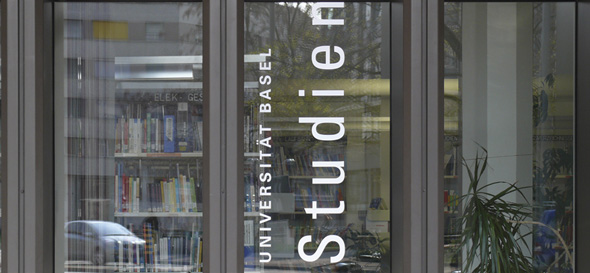
Central services
Central services at the university, long maintained at a bare minimum, underwent their first significant expansion in the 1960s, with the university’s autonomy in 1996 providing another substantial boost.
Shortly before the first expansion, in 1959, Rector Andreas Werthemann proposed a temporary solution to the Department of Education, envisioning it as “an initial step in a comprehensive reorganization.” That December, the Senate established a permanent commission to overhaul university administration. By 1961, however, the situation had grown dire, compelling Rector Edgar Salin to issue an impassioned plea to the department: “In assuming the rectorship, I never intended that all intellectual and humanitarian endeavors, pressing as they are, should languish for months due to a crumbling administration.”
The ensuing years saw modest enhancements to central services, including the addition of a telephone exchange and registry. A pivotal development in strengthening university administration came with the creation of a new role: a permanent assistant to the rotating rectors. Initial deliberations explored expanding the Senate secretary’s honorary position into a semiofficial role, potentially filled by an extraordinary (associate) professor engaged in teaching. The idea of a university chancellor was also contemplated. Ultimately, the position of an assistant – or Adjunkt – to the rector emerged from these various plans. This assistant, joining the rectorate (now a quartet comprising the rector, designated rector, prorector, and assistant), would ensure continuity in managing rectorate affairs, oversee Senate minutes, and head the administration. Notwithstanding the title, the competencies of the position were thus far-ranging, making the Adjunkt a kind of deputy to the rector. Adrien Veillon, former head of the Institute of Law, assumed this position – conceived by Max Imboden – in September 1964. For nineteen years, Veillon served as the right hand to thirteen different rectors before passing the mantle to Mathias Stauffacher in August 1983. Stauffacher, previously the coordination commission’s secretary, continued in this role until 1996. As of 2010, Beat Münch occupied this crucial position.
Before the establishment of the position of the rector’s assistant, the general secretary for the university – an official in Basel’s Department of Education – served as the rector’s primary aide. Following the legendary Jakob Bolli, who had been central to the administration for thirty-eight years, Heinz Bollinger assumed the role in 1958. Alfred Back took over in 1961 for an extended period, succeeded by Hans Joss in 1978. When administrative leadership shifted to the assistant in 1964, the secretary’s main responsibilities evolved to include managing enrollment (and thus the admissions process), editing the course catalog (unless handled by the IT department, led by Georges Rigoni), and preparing annual reports, to which rectors added personal notes in their closing or introductory remarks. Later, under Elsa Suter’s leadership, the central student administration office was established.
While staff turnover occurred, there was notable continuity (with the roles of rector’s assistant and general secretary for the university). Albert Thomann, who began his university service in 1938, served as bedell and dean’s secretary until 1970. Leander Schmid, the longest-serving member of the university administration, led the university office for twenty-five years. Myrta Rinderspacher worked for the university for nearly two decades; first as the dean’s secretary, then for twelve years as the rector’s secretary until 1983, when Elisabeth Heckendorn, who had been with the university administration for twenty-one years, succeeded her. In 1960, the university administration expanded to include a new position: the mater hospitalis. This role involved assisting students with increasingly complex housing and dining issues through individual consultations and promoting student facilities (cafeterias, student residences).
The necessary expansion of the administration, driven by increased workload, is particularly evident in the evolution of the dean’s offices. In the early 1960s, a single dean’s secretary managed tasks for all faculties, supported by institute secretaries (where available) of the respective deans. As this infrastructure proving insufficient, Elsa Oberer was brought in to assist the dean’s secretary, initially handling affairs for three faculties from Albert Thomann’s office.
In May 1963, Rector Max Imboden proposed that the Faculties of Medicine, Science, Theology, and Humanities and Social Sciences should each have a dedicated secretary. Deemed too expansive, the request was scaled back to seek positions for two secretaries to serve all four faculties. The Faculty of Law’s affairs were managed by the head of the Institute of Law. Imboden’s request was partially granted; from fall 1963, each of the four faculties received a part-time secretary, albeit as temporary assistants, as the department was reluctant to make structural commitments. These roles were only expanded to full-time positions at the decade’s end.
Concurrently, administrative services in seminars and institutes saw significant expansion, relieving faculty with heavy teaching loads of administrative tasks. Previously, professors (and sometimes their wives) had handled bookkeeping, and institute directors even conducted annual library inventories. When assistants were hired for such tasks, professors had to compensate them from personal funds.
The increase in positions exacerbated existing space issues. The Governing Council’s 1965 space requirement report stated that providing larger faculties with their own dean’s offices would “in time” become essential. At that point, it was believed that relocating the Economic Archive, whose accommodation in the college building was not originally intended, would resolve the space problem. In 1963, Max Imboden optimistically noted: “We are thus in the fortunate situation that with the removal of the Economic Archive, the administrative needs of the university administration will probably be met for decades.” But this aspiration was only realized some twenty-five years later, when the Economic Archive, along with the economists, moved into the new building in the Rosshof area in 1988.


